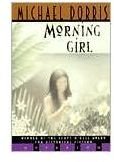Introduce Grades Four and Five Students to "Morning Girl" by Michael Dorris
No matter what time period and no matter what setting, siblings have their differences. Growing into adulthood is often a struggle. It is
no different for a brother and sister of the Taino Indian tribe on a Bahamian island in 1492. Morning Girl is a short, gentle novel written by Michael Dorris for readers between the ages of 9-12. Its lyrical text can be used to study forms of figurative language. The story can help readers imagine what life was life before the European explorers landed and changed life dramatically. Use Morning Girl literature units when developing the art of creative writing and when studying explorers or American natives.
Reading Suggestions
Objective: Demonstrate active listening skills
The author has effectively written the book with two narrators: A sister called Morning Star and a brother called Star Boy. The chapters go back and forth between the siblings and give their own personal perspectives on situations. You may choose to have your girls sit on one side of the room and your boys on the other side and read back and forth to each other.
Another effective presentation would be to use the audio version of the book, which features a young boy and girl to read the content. This version is available at many libraries.
Character Analysis
Objective: Create and use graphic organizers to interpret textual information. Compare and contrast two main characters.
The brother and sister in the story are literally as different as night and day. This is especially evident in the beginning chapters. Use a graphic organizer to list the qualities/characteristics of each sibling. Also add things that each character did in the story. For example, Star Boy was careless with his father’s canoe.
An easy way would be to have a paper divided into three columns. Label one “Morning Girl” another “Star Boy” and the third column can be labeled “Both”. Concentrate on the first two columns during the first few chapters. Gradually students will find commonalities in the siblings and be able to fill in the “Both” column.
Discuss and compare the issues that Morning Girl and Star Boy have in common with sibling issues today.
Figurative Language
Objective: Distinguish how an author establishes mood and meaning through word choice and figurative language.
Materials needed:
Copies of pages from the novel
List of figurative writing definitions on which you want to focus
Review the types of figurative language such as: simile, metaphor, personification, imagery and hyperbole. Then randomly supply students or pairs of students with pages from the novel. Instruct students to scan the reading for figurative writing and write down examples. Share with the class what you have found.
Here’s an example of a simile from the book (page 4): “Mother’s voice was unhappy as a fish pulled into the air from the sea.”
What’s in a Name?
Objective: Students will write a persuasive essay
The book begins with these words, “The name my family calls me is Morning Girl because I wake up early, always with something on my mind.”
Instruct students to choose a name based upon a characteristic which stands out. Then students will write a persuasive essay explaining why the name is the right choice including supporting anecdotes.
Christopher Columbus Arrives

Objective: Gather relevant information from multiple sources.
The final five pages of this novel describe the arrival of strangers to the island. What will this mean to the Taino people? At the end, in the letter by Christopher Columbus, it is mentioned that, “They (the Taino people) should be good and intelligent servants.” Use suggested websites and library reference material to find out how lives changed when Columbus arrived. Present the information in the form of a written or oral report.
In some ways, this book reminds me of Scott O’Dell’s novel <em>Island of the Blue Dolphins</em> because of the primitive setting and the character’s reliance on nature to survive. When you use Morning Girl literature units to work on several Language Arts objectives, you may want to compare the two novels.
References:
Columbus and the Taino Tribe by Jack Weatherford
Columbus in the Caribbean on Caribya.com
Images:
